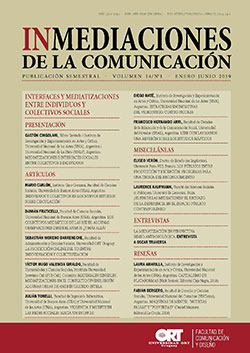Violence and death on social networks: towards a Snuff 2.0
DOI:
https://doi.org/10.18861/ic.2019.14.1.2888Keywords:
snuff myth, social networks, realism, Caught on Tape, ethical spaceAbstract
This article undertakes an exploration around images that, with respect to their socio-cultural performance, are considered abject. It is based on two axes of analysis. A) realism and the impression of reality, considering the evolutionary development of reproduction devices linked to cinema; as well as the configuration and social insertion of those images that have been assumed and are assumed as realistic in the context of modern audiovisual culture. B) The controversy over the diffusion, circulation and consumption of media images of violence and death, taking into account their construction and their effects of meaning. In the present we are faced with a phenomenon propitiated by the Internet, namely that of deaths –by murder, suicide or accident– which are broadcast through social networks. The goal here is to elucidate some fundamental characteristics of this novel object, connected to amateur video and the determinant role of the Internet in the contemporary evolution of the urban myth of snuff movies. Such an object would imply, to a greater or lesser extent, an updating of issues related to audiovisual production and the mentioned myth. We intend to investigate what this supposed updating would consist of.Downloads
References
Astley, M. (2016). Snuff 2.0: Real Death Goes HD Ready. En Jackson, N.; Kimber, S.; Walker, J. & Watson, T. (eds.), Snuff: Real Death and Screen Media (pp. 153-170). Nueva York: Bloomsbury.
Bellour, R. (2008). La Doble Hélice. En La Ferla, J. (ed.), Artes y Medios Audiovisuales: Un estado de situación II. Las Prácticas Mediáticas Predigitales y Postanalógicas (pp.215-237). Buenos Aires: Aurelia Rivera-Nueva Librería.
Dubois, P. (2000). Máquinas de imágenes: Una cuestión de línea general. En Video, Cine, Godard (pp. 9-30). Buenos Aires, Argentina: Libros del Rojas.
Dubois, P. (2000). Video y teoría de las imágenes: Para una estética de la imagen video. En Video, Cine, Godard (pp. 31-50). Buenos Aires: Libros del Rojas.
Dwoskin, E. & Timberg, C. (March 18, 2019). Inside YouTube’s struggles to shut
down video of the New Zealand shooting — and the humans who outsmarted
its systems. The Washington Post. Recuperado de: https://www.washingtonpost.com/technology/2019/03/18/inside-youtubes-struggles-shut-down-videonew-zealand-shooting-humans-who-outsmarted-its-systems/?utm_term=.240d5562eee9. Consultado: 20/03/2019.
Fetveit, A. (2002). Reality TV in the Digital Era: A Paradox in Visual Culture? En J. Freidman (ed.), Reality Squared: Televisual Discourse on the Real. Nueva Jersey y Londres: Rutgers University Press.
Graham, R. & Parry, H. (August 18, 2017). California girl, 18, who live-streamed
‘drunken’ crash that killed her younger sister, 14, on Instagram breaks down in tears in court as she’s denied lower a bail. Daily Mail. Recuperado de: https://www.dailymail.co.uk/news/article-4740490/No-bail-reduction-California-crashrecorded-Instagram.html. Consultado: 24/11/18.
Goldsmith, K. (2015). Hacia una poética del hiperrealismo. En Escritura no-creativa. Gestionando el lenguaje en la era digital (pp. 129-163). Buenos Aires: Caja Negra.
Harper, P. y Mullin, G. (February 28, 2019). Death On Camera: How Facebook Live murder and suicide videos are spreading online and what you should do if you spot inappropriate content”. The Sun. Recuperado de: https://www.thesun.co.uk/news/3426352/facebook-live-clips-murder-suicide-shootings-report/. Consultado: 5/03/2019.
Kerekes, D. & Slater, D. (1995). Killing for Culture: An Illustrated History of Death Film from Mondo to Snuff. Londres: Creation Books.
Smith, G. (2004). Final Cuts: The History of Snuff Films. En Fringe Underground. Recuperado de: http://www.fringeunderground.com/snuff.html.
Sobchack, V. (2004). Inscribing Ethical Space: Ten Propositions on Death, Representation, and Documentary. En Carnal Thoughts: Embodiment and Moving Image Culture (pp. 226-258). Berkeley, Estados Unidos: University of California Press.
Steimberg, O. (1998). Semiótica de los medios masivos. Buenos Aires: Atuel.
Tonelli, J. (2015). Límites de la realidad, límites de la ficción. El caso de Efectos especiales. Lexia. Rivista di Semiotica, 21, 83-96
Tonelli, J. (2017). Una imagen muda. El misterioso caso de Elisa Lam. En Tassara, M. (coord.), Cuadernos del Instituto. Investigación y Experimentación en Arte y Crítica (pp. 88-96). Buenos Aires: Universidad Nacional de las Artes.
Traversa, O. (2001). Aproximaciones a la noción de dispositivo. Signo y Seña, 12, 231-248. Recuperado de: https://dialnet.unirioja.es/ejemplar/89499
Verón, E. (1987). La semiosis social. Buenos Aires: Gedisa.
Verón, E. (2004). Cuando leer es hacer: la enunciación en el discurso de la prensa gráfica. En Fragmentos de un tejido (pp. 171-191). Barcelona: Gedisa.
West, A. (2005). Caught on Tape: A Legacy of Low-Tech Reality. En King, G. (ed.), The Spectacle of the Real (pp. 83-92). Bristol: Intellect Books.





